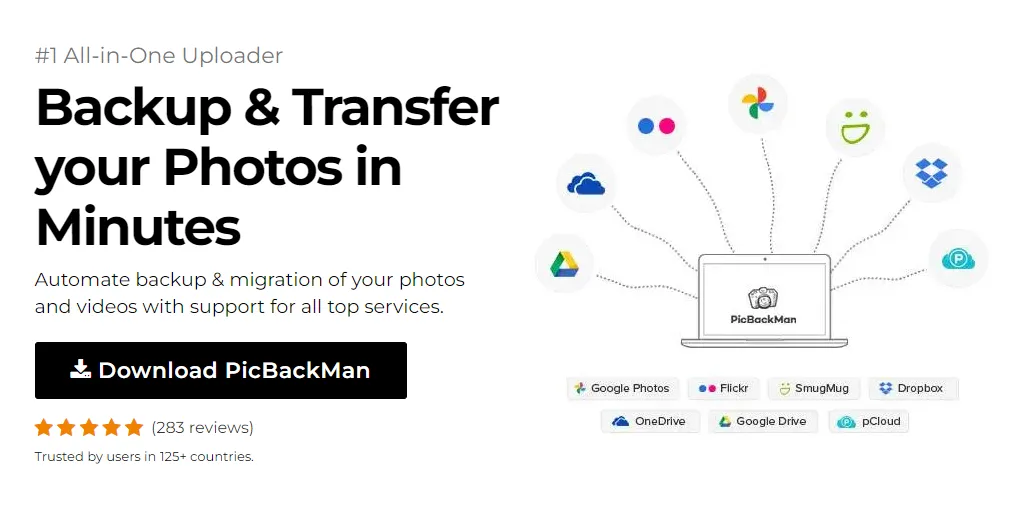Why is it the #1 bulk uploader?
- Insanely fast!
- Maintains folder structure.
- 100% automated upload.
- Supports RAW files.
- Privacy default.
How can you get started?
Download PicBackMan and start free, then upgrade to annual or lifetime plan as per your needs. Join 100,000+ users who trust PicBackMan for keeping their precious memories safe in multiple online accounts.
“Your pictures are scattered. PicBackMan helps you bring order to your digital memories.”
How to Free up Google Drive Space?

Running out of Google Drive storage can be frustrating, especially when you need to save important files. I've been there too—trying to upload a crucial document only to see that dreaded "Storage Full" notification. The good news is that clearing space on your Google Drive is simpler than you might think.
In this guide, I'll walk you through practical steps to free up your Google Drive space quickly and efficiently. From finding large files to managing your Gmail attachments, you'll learn everything you need to know about reclaiming your cloud storage.
Why Your Google Drive Space Fills Up Fast
Before diving into the cleanup process, it's helpful to understand what's eating up your storage. Google Drive offers 15GB of free space, but this storage is shared across Google Drive, Gmail, and Google Photos. Here's what typically consumes your storage:
- Large files and documents in Drive
- Email attachments in Gmail
- Photos and videos in Google Photos
- Shared files that you've added to your Drive
- Backups from your mobile devices
Now let's look at how to free up this space step by step.
Quick Ways to Check Your Google Drive Storage
First, you need to know how much space you have and what's using it up:
Method 1: Check via Google Drive
- Go to drive.google.com
- Look at the bottom left corner of the screen
- You'll see how much storage you've used and your total available storage
Method 2: Check via Google One
- Visit one.google.com/storage
- Sign in with your Google account
- You'll see a detailed breakdown of your storage usage across Drive, Gmail, and Photos
This breakdown is extremely useful because it shows you exactly which service is using the most space, helping you target your cleanup efforts.
10 Effective Ways to Free Up Google Drive Space
1. Delete Large Files First
The most efficient way to free up space quickly is to target your largest files first:
- Go to Google Drive
- Click on "Storage" in the left sidebar
- Your files will automatically be sorted by size, with the largest at the top
- Select the large files you don't need and click the trash icon
Looking for files by size on mobile? Open the Google Drive app, tap the menu icon, select "Storage," and you'll see your files sorted by size. This makes it easy to identify storage-hogging files even when you're on the go.
Alternatively, you can use this search query in Google Drive: "storage: 100MB" (adjust the number to find files of different sizes).
2. Empty Your Trash
Deleted files in Google Drive aren't immediately removed—they sit in the Trash for 30 days, still counting against your storage quota.
- Click on "Trash" in the left sidebar of Google Drive
- Review the contents to make sure there's nothing you want to keep
- Click "Empty trash" at the top right
- Confirm the permanent deletion
Once you empty the trash, these files are permanently deleted and the space is reclaimed.
3. Find and Remove Duplicate Files
Duplicate files can waste significant storage space. Here's how to find them:
- In Google Drive, type "title:duplicate" in the search bar
- Look through the results for files with identical or similar names
- Preview files to confirm they're duplicates
- Delete the copies you don't need
For a more thorough approach, you can also search for specific file types and then manually check for duplicates:
- Type "type:image" to find all images
- Type "type:video" for videos
- Type "type:pdf" for PDF documents
4. Clear Out Shared Files You Don't Need
Files shared with you don't count against your storage unless you add them to your Drive. If you've added shared files to your Drive, consider removing ones you no longer need:
- Go to Google Drive and click on "Shared with me" in the left sidebar
- Right-click on files you no longer need
- Select "Remove" to remove them from your Drive (this doesn't delete the original file)
5. Convert Files to Google's Native Formats
Files in Google's native formats (Docs, Sheets, Slides) don't count toward your storage limit! Convert compatible files to save space:
- Upload your file to Google Drive if it's not already there
- Right-click on the file
- Select "Open with" and choose the appropriate Google app (e.g., Google Docs for Word files)
- Once open, go to File > Save as Google Docs/Sheets/Slides
- After confirming the new file works correctly, delete the original
| Original Format | Convert To | Storage Impact |
|---|---|---|
| Microsoft Word (.docx) | Google Docs | Doesn't count toward storage |
| Microsoft Excel (.xlsx) | Google Sheets | Doesn't count toward storage |
| Microsoft PowerPoint (.pptx) | Google Slides | Doesn't count toward storage |
| Text files (.txt) | Google Docs | Doesn't count toward storage |
6. Manage Your Gmail Storage
Gmail can take up a significant portion of your Google storage, especially if you have lots of attachments:
- Go to Gmail
- In the search bar, type "has:attachment larger:10MB" (adjust the size as needed)
- Review and delete emails with large attachments that you no longer need
- Don't forget to empty your Gmail trash afterward
You can also search for emails with specific types of attachments:
- "filename:.pdf" for PDF files
- "filename:.jpg OR filename:.png" for images
- "filename:.mp4 OR filename:.mov" for videos
7. Optimize Google Photos Storage
Google Photos can consume a lot of storage, especially with high-resolution images and videos:
- Go to photos.google.com
- Click on "Settings" (gear icon)
- Select "Storage management"
- You'll see options to review and delete large photos and videos, blurry photos, screenshots, and more
Consider these additional options for Google Photos:
- Delete duplicates and similar photos
- Remove screenshots you no longer need
- Delete photos from apps and messaging services that were automatically backed up
Before deleting photos and videos, download anything important to your local device. Go to Google Photos, select the items you want to save, click the three dots in the top-right corner, and choose "Download." This creates a backup before you free up space.
8. Remove Unused Apps and Their Data
Third-party apps connected to your Google Drive can store data that counts against your quota:
- Go to myaccount.google.com/permissions
- Look for apps that have access to your Google Drive
- Remove access for apps you no longer use
- Return to Google Drive and check for folders created by these apps, which you can now delete
9. Download and Remove Files You Rarely Access
For files you want to keep but don't need regular access to:
- Select the files in Google Drive
- Right-click and select "Download"
- Save them to an external hard drive or your computer
- After confirming the download is complete, delete them from Google Drive
Creating a Backup System
Consider establishing a regular backup routine for your important files:
- Use an external hard drive for long-term storage
- Set up a monthly reminder to download and back up new files
- Consider using a different cloud service for redundancy
10. Use Google's Storage Management Tool
Google offers a built-in tool to help manage your storage:
- Go to one.google.com/storage/management
- You'll see recommendations for files you can remove to free up space
- Review the suggestions in each category (large files, emails with attachments, etc.)
- Select items to delete and confirm
Comparing Storage Management Approaches
| Method | Effort Required | Space Saved | Best For |
|---|---|---|---|
| Deleting large files | Low | High | Quick results |
| Converting to Google formats | Medium | Medium | Document-heavy users |
| Managing Gmail | Medium | Medium to High | Long-time Gmail users |
| Optimizing Photos | Medium | Very High | Photo/video enthusiasts |
| Downloading & removing | High | High | Archiving purposes |
Preventing Google Drive from Filling Up Again
After clearing space, you'll want to keep it that way. Here are some habits to develop:
Regular Maintenance Schedule
- Set a calendar reminder to clean up your Drive monthly or quarterly
- Focus on different areas each time (Drive, Gmail, Photos)
- Use the Storage Management tool regularly to catch problem areas
Smart Storage Practices
Adopt these habits to minimize storage use:
- Use Google's native formats whenever possible
- Download and delete files after projects are completed
- Regularly clean out your Downloads folder on your computer (these often get re-uploaded)
- Be selective about what photos and videos you back up
- Delete email attachments after downloading them
Consider Upgrading to Google One
If you consistently need more space, Google One offers affordable storage upgrades:
- 100GB for $1.99/month
- 200GB for $2.99/month
- 2TB for $9.99/month
Google One also includes additional benefits like expanded customer support, family sharing options, and extra features in some Google apps.
Troubleshooting Common Google Drive Storage Issues
Storage Not Freeing Up After Deletions
If you've deleted files but your storage hasn't updated:
- Make sure you've emptied the trash
- Wait 24-48 hours for the storage calculation to update
- Clear your browser cache or try a different browser
- Check if the files are still synced on another device
Can't Delete Certain Files
If you're having trouble deleting specific files:
- Check if they're shared with restricted permissions
- Try deleting them from a different device
- Use the Google Drive web interface instead of the mobile app
- Contact Google support if the problem persists
Storage Shows Full But No Files Visible
Sometimes your storage shows as full, but you can't find the files taking up space:
- Check all three services (Drive, Gmail, Photos)
- Look for hidden folders or files in Drive (use the "All items" view)
- Check for large files in the "Computers" section if you've used Backup and Sync
- Use the Storage Management tool for a complete analysis
Quick Tip to ensure your videos never go missing
Advanced Tips for Google Drive Power Users
Use Google Drive Desktop for Selective Sync
The Google Drive desktop app allows you to choose which folders sync to your computer:
- Download and install Google Drive for desktop
- Click the Drive icon in your system tray or menu bar
- Go to Settings > Google Drive > Choose folders to sync
- Select only the folders you need regular access to
This keeps your local storage manageable while maintaining access to all your files in the cloud.
Create Shared Drives for Team Projects
If you use Google Workspace, Shared Drives (formerly Team Drives) can help manage storage:
- Files in Shared Drives count against the organization's storage, not individual quotas
- When team members leave, the files remain accessible
- Permissions are managed at the drive level for easier administration
Use Third-Party Tools for Advanced Management
Several tools can help with more complex Drive management:
- Dropbox Backup for Google: Backs up your Google data to Dropbox
- MultCloud: Transfers files between cloud services
- GAT+: Provides advanced Google Workspace administration and analytics
Frequently Asked Questions
Why did my Google Drive fill up so quickly?
Your Google Drive storage is shared across Drive, Gmail, and Google Photos. High-resolution photos and videos, email attachments, and large files can quickly consume your 15GB free allocation. Regular backups from mobile devices can also silently fill your storage without you realizing it.
Will deleting emails free up Google Drive space?
Yes! Since Gmail shares the same storage quota as Google Drive, deleting emails with large attachments and emptying your Gmail trash will free up space for your Drive files. Focus on emails with attachments larger than 10MB for the most impact.
How long does it take for deleted files to free up space?
After permanently deleting files (emptying the trash), it typically takes 24-48 hours for your storage quota to reflect the changes. If it takes longer, try clearing your browser cache or contacting Google support.
Do Google Docs, Sheets, and Slides count toward storage?
No, files created in or converted to Google's native formats (Docs, Sheets, Slides, Forms, Sites, and Jamboard) don't count toward your storage quota. This makes converting compatible files to Google formats an excellent way to save space.
What happens if I exceed my Google Drive storage limit?
If you exceed your storage limit for an extended period (usually 2+ years), Google may restrict your ability to upload new files to Drive, receive emails in Gmail, and back up photos. In extreme cases, some content might be deleted. You'll receive multiple warnings before any deletion occurs.
Conclusion
Managing your Google Drive storage doesn't have to be overwhelming. By following the steps in this guide—deleting large files, emptying your trash, converting to Google formats, and managing your Gmail and Photos—you can free up significant space quickly.
Regular maintenance is key to keeping your storage in check. Set up a cleaning schedule, be mindful of what you upload, and consider upgrading to Google One if you consistently need more space.
With these strategies, you'll be able to make the most of your Google Drive storage and avoid those frustrating "out of space" messages when you need to save important files.






